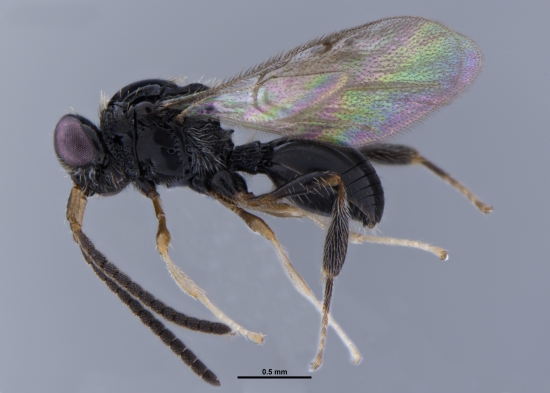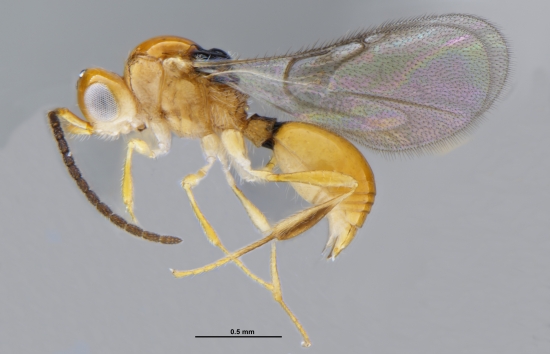

For taxonomists, there is nothing more awe-inspiring than finding a fantastic new species, something that probably no one has ever seen before! And it is more fun when such a new species is found from the backyard of your workplace. Recently, a team led by Dr. LUO Shixiao at South China Botanical Garden of Chinese Academy of Sciences and Dr. CHEN Huayan at Sun Yat-sen University, discovered a rare new parasitoid species named Ismarus areolatus (Fig. 1) from the botanical garden. The new species belongs to a rare parasitoid family Ismaridae, which only has about 60 described species worldwide and less than 10 species from China. Including I. areolatus, the researchers also discovered another new species Ismarus paradorsiger (Fig. 2) in their new paper published in the Journal of Hymenoptera Research.
Specie of Ismaridae are actually hyperparasitoids of Dryinida, which are parasitoids of Auchenorrhyncha (Hemiptera), such as leafhoppers, planthoppers and treehoppers (Fig. 3). Studies suggested species of Ismaridae are likely to be found from wooded areas at higher elevations in warmer climatic zones and at low elevations in cooler climatic zones. However, the new species I. areolatus were found occur in SCBG and Yunkaishan Mountain, where are at low elevations in warmer climatic zone.
This finding suggests that ismarids might be able to adapt to wider ranges than previously thought. Dryinidae are important natural enemies of leafhoppers in forestry and agriculture and some species have been successfully used in the biological control of leafhoppers. While ismarids are hyperparasitoids of Dryinidae, therefore may diminish the effectiveness of Dryinidae against leafhoppers. “Understanding their adaptation to environment and climate can help us work to reduce the negative effect of ismarids on Dryinidae species in biological control programs.” Dr. CHEN said.
Dr. CHEN continued, “As ismarids are natural enemies of Dryinidae and you would think that they should be considered as pests. True! But their diversity is still worth studying. A healthy ecosystem should include a stable composition of all kinds of organisms from different trophic levels. The presence of ismarids indicates a high diversity and abundance of Dryinidae present in the botanical garden and Dryinidae species should play a key role in keeping the leafhopper populations in check. So, you can use ismarids as bioindicators to access the health of the ecosystem.” Dr. LUO added, “Actually, we have been monitoring the diversity of insects using Malaise traps in the garden in the last two years. We have found about ten Dryinidae species in the garden and some of these parasitoids have quite high parasitisms on leafhoppers. That is to say, these Dryinidae parasitoids are an important natural factor keeping the leafhopper populations in check. Our finding suggests that botanical gardens are not a refuge for endangered plants but also a place where diverse insects can thrive, even if these gardens locate in a bustling big city.”
For further reading, please refer to: https://doi.org/10.3897/jhr.82.62148.

Figure 1. Ismarus areolatus Chen, 2021 (Photo by CHEN Huayan)

Figure 2. Ismarus paradorsiger Chen, 2021 (Photo by CHEN Huayan)

Figure 3. A. A leafhopper parasitized by Dryinidae. B. A nymphal planthopper parasitized by Dryinidae. Arrows showing the lava of Dryinidae. (Photos by CHEN Huayan)

